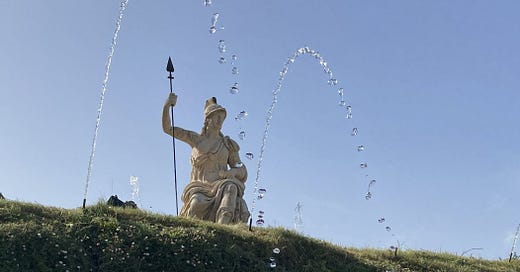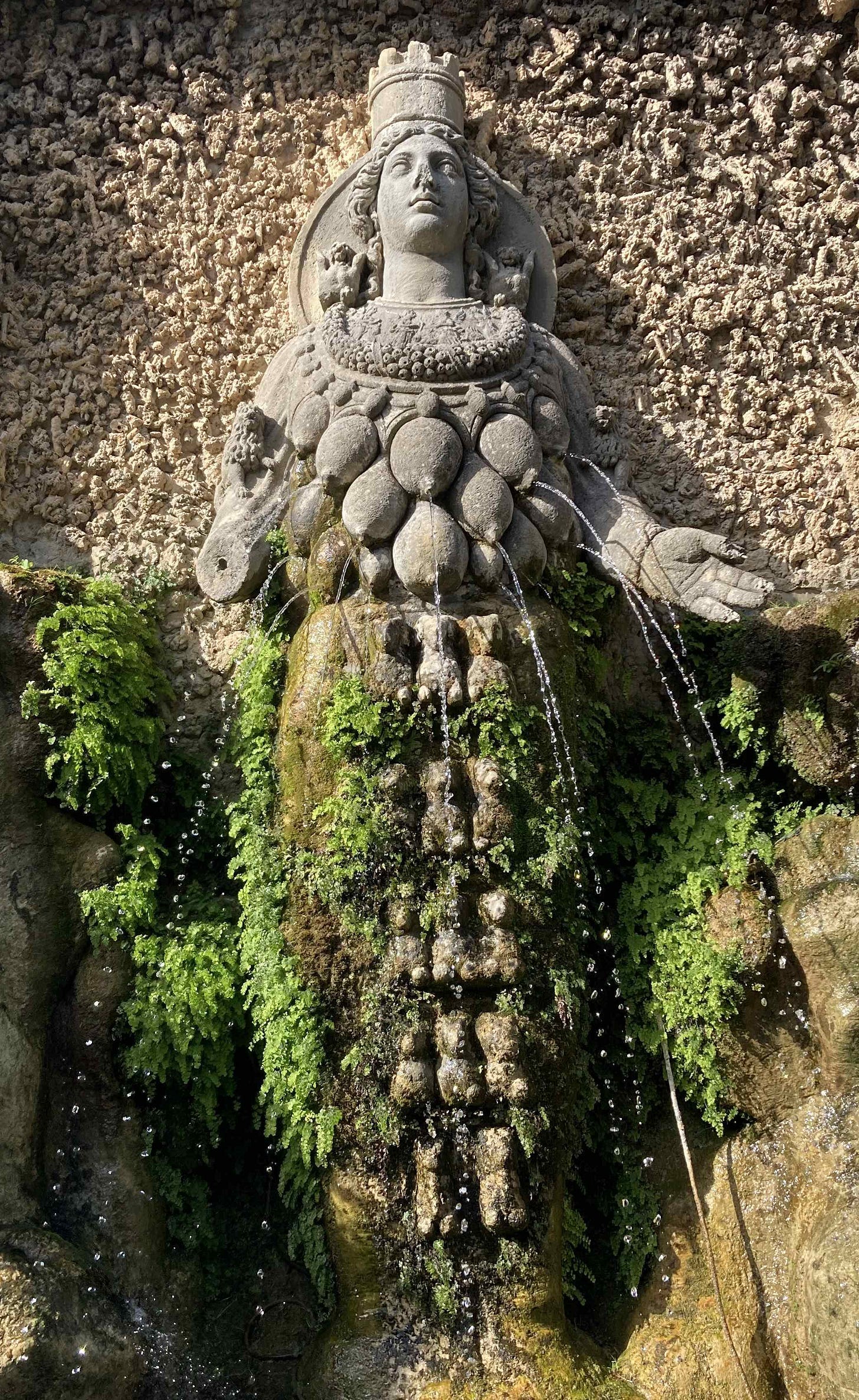Fountains of corruption
Indulgence and innuendo at the Villa D'Este (4 minute preview, 7 minute full read)
Even as I watch the sun sparkle through a graceful arc of water, I can’t dismiss the disquiet this place evokes in me. It isn’t what I’m seeing, because this garden is exquisite. I love to see and hear water in a garden. Ever since I was a child, fountains and ponds have delighted me. And there are probably no finer fountains and ponds than those in the gardens of the Villa D’Este, in Tivoli, a charming town to the north-east of Rome.
I visited these gardens in 2022, taking a day tour from Rome to see them, along with the nearby ruins of Hadrian’s Villa, which was built for the Roman Emperor Hadrian around 1900 years ago. I first began to feel the disquiet at Hadrian’s Villa. I realised that almost all of the Roman ruins I had previously seen were public buildings, such as the Forum, the Colosseum and the Pantheon. Hadrian’s Villa, however, was a private place of vast excess. It made me think of those who were living in poverty or enslavement (or both) in Rome at the time the villa was built.
The crumbling walls and broken columns of Hadrian’s Villa invite the imagination to reconstruct what must have once existed. A visit to the Villa D’Este gives that imagined picture substance, because some of the marble and statues which still adorn it were looted from Hadrian’s Villa. I particularly notice the multicoloured marble making up the garden’s wide paths. It’s familiar to me, because I’ve seen it in many a Renaissance church, but it’s not Renaissance-era marble. It is ancient Roman marble, quarried from distant corners of the empire nearly 2000 years ago.
The stolen marble is one reason I’m troubled by the Villa D’Este. Another is that this, too, was created as a private place. The excesses here are even more apparent than at Hadrian’s Villa, partly because it’s in better condition but particularly because of the water. When I visited the gardens of the Vatican, another place of excess and indulgence, the only fountains flowing were those surrounding a deep pond, which was perhaps fed by a spring. All the rest, I was told by the guide, had been shut off at the behest of Pope Francis, to avoid wasting water. At the Villa D’Este, there are dozens of different fountains, with hundreds of individual jets of water. I wondered about the quality and quantity of water available to the average citizen of Tivoli at the time the villa and gardens were built.
The Villa D’Este is named for the Este family, one of the most powerful and wealthy families in Medieval and Renaissance Italy. Building was begun in 1560 by Cardinal Ippolito D’Este, who was the second son of the Duke of Ferrara and Lucrezia Borgia. Yes, that Lucrezia Borgia, the woman whose name is a byword for intrigue, scandal and poison. Which brings me to the final reason for my disquiet – the association of the Villa D’Este with such a vile dynasty as the Borgia family.
All is not as it appears, however. The reputation of Lucrezia Borgia owes much to a play by Victor Hugo and a Donizetti opera based on the play. But there’s virtually nothing factual in Hugo’s play. A woman called Lucrezia Borgia did exist… and that’s about the extent of Hugo’s historical accuracy. The rest of it is just a character assassination. There’s no evidence that she poisoned anyone, let alone her own son, as she does in the play. There were accusations made against her during her lifetime, but they were made by her former husband, after he’d fled because his family was no longer useful to her father, and he feared for his life.
The Borgia name is justified as a byword for intrigue, scandal and probably poison, but not because of Lucrezia. Her father Rodrigo Borgia, on the other hand, seems to deserve the reputation. His uncle, Pope Callixtus III, made the questionable decision to appoint Rodrigo as a cardinal when he was only 25. Rodrigo used his position to acquire enormous wealth, patronise the arts and support his numerous children, including his son, Cesare and daughter Lucrezia, who were two of the four children he had with his most well-known mistress, Vannozza Catanei. If this doesn’t sound like the kind of behaviour you’d expect from a cardinal, just wait, it gets worse.
In 1492, amid allegations of corruption, Rodrigo entered a papal conclave and emerged as Pope Alexander VI. At this time, Lucrezia was 13, and had already been betrothed twice. Once Rodrigo became pope, he annulled the second betrothal and had her married to a 28 year-old whose family he needed as allies. He annulled that marriage four years later and married Lucrezia to a 17 year old whose family he needed more. Two years later, he no longer needed them and Lucrezia’s husband was conveniently killed by one of Cesare’s servants. In case you aren’t keeping track, Cesare is the pope’s son and Lucrezia’s brother, and he’s also a cardinal at this point. Oh, and the inspiration for Niccolò Machiavelli’s book, The Prince.
Before I go on, I should mention that Cesare Borgia was one of Allison Epstein’s dirtbags, on her wonderful Substack, Dirtbags Through the Ages. Check it out for more on Cesare and many more of history’s entertainingly dreadful people.
There’s much more which could be said about Rodrigo and Cesare, but I want to focus on Lucrezia, because her story is much more ambiguous and intriguing.







